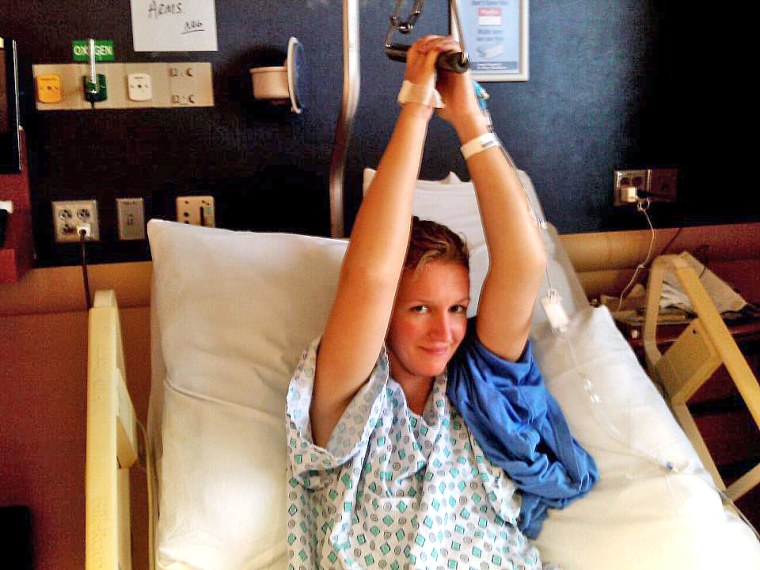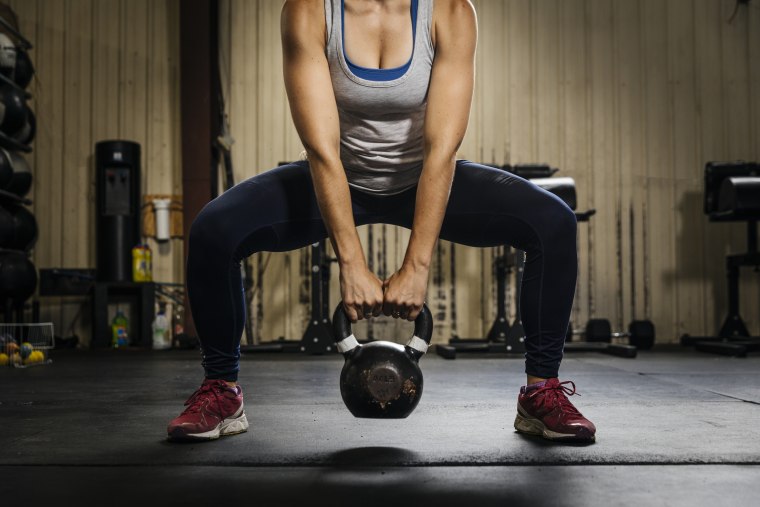I got a jump start on my New Year’s fitness goal a few years ago with a killer workout on New Year’s Eve. And when I say killer, I mean that literally.
My fitness goal for the year was a kettlebell trifecta called Iron Maiden that included a weighted pull-up with a 24 kg (about 53 pounds) kettlebell attached to a belt. That was about half my body weight, so to reach this lofty goal I’d have to push hard to increase upper body strength beyond what a couple years of powerlifting had already built.
So, freshly back from a holiday travel break, I hit the gym with a personal trainer where I did pull-ups until I couldn’t do another. Then he spotted me till I had nothing left. Then more work on machines and with dumbbells until my arms wouldn’t straighten. “What a great workout!” I thought later when I couldn’t maneuver my arms to put my coat on.
The pain struck that night, like a charlie horse in my bicep. The following day I still couldn’t move my arms, and the next day my left arm looked like a giant sausage. When I took to Facebook the following morning to describe the situation a fellow lifting friend warned me it could be rhabdo, shorthand for exercise-induced rhabdomyolysis.
Sure enough, when I got to my sports doctor shortly after this frightening warning (this was not my first sports injury so he was basically on speed dial), it was straight to the hospital after testing revealed that I indeed had rhabdo.

To failure and beyond
From one non-scientist fitness enthusiast to another, here’s what happened: In a healthy workout, muscles get micro-tears and release small amounts of a toxic protein called myoglobin that passes through your system harmlessly. Your muscles rebuild the damage during recovery and grow stronger.
“When we strength train we’re putting our body under stress but it’s calculated, and done in a systematic way,” explained physical therapist Erika Mundinger, an independent contract PT strength coach for The Movement Minneapolis.
But, in a workout that pushes too far, going beyond failure, “you are dumping toxins into the system … and your body can’t keep up with filtering,” Mundinger said. The resulting increase in the enzyme creatine kinase (CK) is too much for your kidneys and liver, and they can shut down.
When my physician tested my CK levels the number was above 40,000 — about 400 times higher than normal. I was fit, healthy and in my 30s and he told me I faced liver damage, danger of seizing, acute renal kidney failure and heart attack.
The elevated CK is not the only danger though, because meanwhile your body is “moving stuff in to help flush the waste out,” Mundinger said. With so much “stuff pouring out of cells because they’re damaged,” fluid can’t move out of the area. That creates massive swelling which “can almost suffocate the muscles and that’s where you get necrosis,” she said. And indeed, by the time I got to my doctor the muscles in my arm were necrotic —dead.
I turned out to be lucky. Staying in a hospital bed with my arm suspended overhead reduced the swelling, and nine days of carefully calibrated intravenous fluids reduced the CK levels enough to let me return home to heal and begin a long, slow rehabilitation process. Scared straight, I dropped my ambitious fitness goal (and the trainer).
No pain, no gain?
While exercise induced rhabdo like mine is rare, cases have grown in recent years along with the trend toward intense exercise, according to an October 2018 article in Weill Cornell Medicine’s magazine. And periodically a public figure will appear in the media after their own bout; paralympic medalist Amy Purdy shared her scary rhabdo run-in on Instagram.
There is nothing shameful in stopping because you’re tired. If anything that is the absolute smartest thing you can do because you can [work out] again tomorrow.
Erika Mundinger, physical therapist
So how can you make sure your own fitness resolution doesn’t have dire consequences? “We’re conditioned to say when we feel the burn we should do more,” Mundinger said, which can put us at risk of going too far. Competitive group classes and overzealous coaches can also spur a workout that crosses the line.
Of course everyone says to listen to your body, but how do you actually know when you’re in dangerous territory? If you have something left, and someone’s screaming to keep going, shouldn’t you?
The red flag that you should put the brakes on a workout, Mundinger said, is when your form changes — or when you are compensating with different muscles or alignment — just to try to finish the workout. “When you do three sets of 15 and you hit rep 10 and you’re all of a sudden trying to alter your form so you can get through the reps, that is when you need to stop.”
For anyone who’s ever been in a class and didn’t want to be the first to stop, didn’t want to look weak, that’s tough. But “be honest with yourself,” Mundinger said. “Who are you being a hero for?” Even if you don’t get rhabdo from overdoing it, ask yourself what you’re gaining, she said. Is it psychological? Is it so you can post an Instagram about your success? Because it’s not making you stronger. “There is nothing shameful in stopping because you’re tired,” she said. “If anything that is the absolute smartest thing you can do because you can [work out] again tomorrow.”
And if it’s the trainer or class instructor shouting you on? “They’re trying so hard to be motivators,” Mundinger said. “And we feel like we’re going to let them down and look lazy [if we stop].” But even though “they're drill sergeants, most of them are going to listen,” she said.
If they don’t? “They’re not holding a gun to your head,” she said. Also? “It might be time to rethink the trainer or the group fitness. It’s one thing to push and be motivating and it’s another thing to be dangerous.”
Key to remember in any high intensity workout, she added, is to “be sure you don’t do the same muscle group movement after movement after movement.” Be especially aware of any new-to-you exercise, another culprit in rhabdo cases. Mundinger worked with one client who got rhabdo in her arms from pulling the reins the first time she’d ridden a horse in years. Also be cautious after taking a break. I’d skipped my workouts during three weeks of travel before my overly ambitious return to the gym. Student athletes returning to tough workouts after vacation tend to land in the news when they get rhabdo. And be sure you’re drinking plenty of fluids, as being deyhrated can also be a contributing factor.
It’s just a workout
If you do see warning signs after a workout — like excruciating pain and soreness, massive swelling or dark urine — get medical help right away, said Mundinger. Now’s not the time to wait for your family doctor to fit you in. “You probably want to go to an emergency physician,” she said.
But you can avoid this altogether by being smart. At the end of the day, remember, “it’s just a workout and it’s just a New Year’s resolution and you’ve got 12 more months to reach your fitness goals," Mundinger said. "You don’t have to meet it in week one."
BETTER ways to tackle New Year's resolutions
- How to make your New Year's resolution stick, according to psychologists
- The 5-step plan this weight-loss coach uses to motivate her laziest clients
- 7 (totally doable) New Year's resolutions that will change your life
- 3 ways to make your resolutions stick
- Use micro habits to tackle big health and productivity goals
Want more tips like these? NBC News BETTER is obsessed with finding easier, healthier and smarter ways to live. Sign up for our newsletter and follow us on Facebook, Twitter and Instagram.



